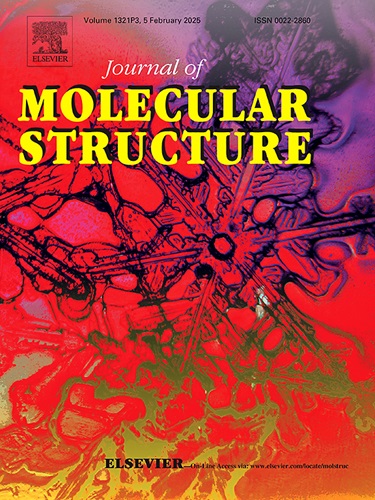Biosynthesis of BiFeO3 for BiFeO3@Ag-S-CH2-COOH as the nanocatalyst for one-pot synthesis of 2, 3-dihydroquinazolin-4(1H)-ones and their anti-blood cancer activity
IF 4
2区 化学
Q2 CHEMISTRY, PHYSICAL
引用次数: 0
Abstract
In this research, BiFeO3 nanoparticles were synthesized using an extract from the leaves of Abelmoschus esculentus L. Moreover a novel BiFeO3@Ag-S-CH2-COOH nanocatalyst was developed through biosynthesis of BiFeO3 and successfully employed for the one-pot synthesis of 2,3-dihydroquinazolin-4(1H)-ones. The BiFeO3@Ag-S-CH2-COOH nanocatalyst was characterized using Fourier-transform infrared spectroscopy (FT-IR), X-ray diffraction (XRD), Brunauer-Emmett-Teller (BET) analysis, high-resolution transmission electron microscopy (HR-TEM), field emission scanning electron microscopy (FE-SEM), energy-dispersive X-ray spectroscopy (EDX), thermogravimetric analysis-differential thermal analysis (TGA-DTA), and X-ray photoelectron spectroscopy (XPS) techniques. The greener BiFeO3@Ag-S-CH2-COOH nanoparticles demonstrated remarkable catalytic efficiency in the production of 2,3-dihydroquinazolin-4(1H)-ones. These magnetic nanoparticles exhibited excellent catalytic efficiency, could be readily separated with an external magnet and maintained high reusability with minimal decline in activity. The structures of the synthesized 2,3-dihydroquinazolin-4(1H)-one derivatives were validated using FT-IR, 1H and 13C nuclear magnetic resonance (NMR), and mass spectrometry. Furthermore, these compounds were assessed for their anticancer activity against the NALM-19 blood cancer cell line.
BiFeO3的生物合成BiFeO3@Ag-S-CH2-COOH作为一锅合成2,3 -二氢喹唑啉-4(1H)-的纳米催化剂及其抗血癌活性
通过生物合成 BiFeO3,开发了一种新型 BiFeO3@Ag-S-CH2-COOH 纳米催化剂,并成功用于 2,3-二氢喹唑啉-4(1H)-酮的一锅合成。研究人员使用傅立叶变换红外光谱(FT-IR)、X 射线衍射(XRD)、Brunauer-Emmett-Teller(BET)分析、高分辨率透射电子显微镜(HR-TEM)对 BiFeO3@Ag-S-CH2-COOH 纳米催化剂进行了表征、场发射扫描电子显微镜 (FE-SEM)、能量色散 X 射线光谱 (EDX)、热重分析-差热分析 (TGA-DTA) 和 X 射线光电子能谱 (XPS) 技术。更环保的 BiFeO3@Ag-S-CH2-COOH 纳米颗粒在生产 2,3-二氢喹唑啉-4(1H)-酮的过程中表现出显著的催化效率。这些磁性纳米粒子表现出卓越的催化效率,可通过外部磁铁轻松分离,并可保持较高的重复利用率,且活性下降极小。合成的 2,3-二氢喹唑啉-4(1H)-酮衍生物的结构通过傅立叶变换红外光谱、1H 和 13C 核磁共振(NMR)以及质谱进行了验证。此外,还评估了这些化合物对 NALM-19 血癌细胞系的抗癌活性。
本文章由计算机程序翻译,如有差异,请以英文原文为准。
求助全文
约1分钟内获得全文
求助全文
来源期刊

Journal of Molecular Structure
化学-物理化学
CiteScore
7.10
自引率
15.80%
发文量
2384
审稿时长
45 days
期刊介绍:
The Journal of Molecular Structure is dedicated to the publication of full-length articles and review papers, providing important new structural information on all types of chemical species including:
• Stable and unstable molecules in all types of environments (vapour, molecular beam, liquid, solution, liquid crystal, solid state, matrix-isolated, surface-absorbed etc.)
• Chemical intermediates
• Molecules in excited states
• Biological molecules
• Polymers.
The methods used may include any combination of spectroscopic and non-spectroscopic techniques, for example:
• Infrared spectroscopy (mid, far, near)
• Raman spectroscopy and non-linear Raman methods (CARS, etc.)
• Electronic absorption spectroscopy
• Optical rotatory dispersion and circular dichroism
• Fluorescence and phosphorescence techniques
• Electron spectroscopies (PES, XPS), EXAFS, etc.
• Microwave spectroscopy
• Electron diffraction
• NMR and ESR spectroscopies
• Mössbauer spectroscopy
• X-ray crystallography
• Charge Density Analyses
• Computational Studies (supplementing experimental methods)
We encourage publications combining theoretical and experimental approaches. The structural insights gained by the studies should be correlated with the properties, activity and/ or reactivity of the molecule under investigation and the relevance of this molecule and its implications should be discussed.
 求助内容:
求助内容: 应助结果提醒方式:
应助结果提醒方式:


